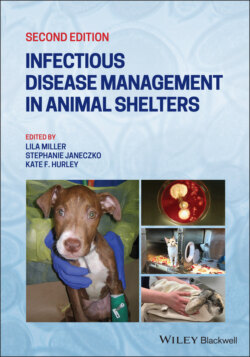Читать книгу Infectious Disease Management in Animal Shelters - Группа авторов - Страница 78
3.2.1 Importance of Disease Surveillance
ОглавлениеKnowing the nature and extent of disease occurrence in shelter populations enables veterinarians to:
assess population health in quantitative terms
set objective and measurable disease‐related priorities
identify outbreaks
plan and monitor the effectiveness of preventive and control measures
rapidly identify “new” diseases/conditions
justify grant proposals, and
clearly communicate the health of their populations to interested constituencies (e.g. Boards of Directors, funding agencies, community).
The basic metrics of interest in disease surveillance in shelters are measures of morbidity (frequency of illness such as incidence), and mortality (frequency of death). Recommended definitions of these metrics for use in animal shelters have been discussed (Scarlett et al. 2017a). An incidence rate is defined as the number of newly diagnosed cases of a particular disease divided by the number of animals that could develop that disease in a specified period. This fraction is usually multiplied by 100 and expressed as a percentage. By comparison, prevalence refers to the percentage of cases of a particular disease that are present in a particular population at a given time. In this chapter, the terminology “frequency of disease” is used to encompass the disease incidence or prevalence, as well as death resulting from or euthanasia that occurs because of a particular disease. One of these terms (e.g. incidence) is used when the discussion pertains to that metric alone.
If disease incidence is increasing, it is important to ascertain why and to intervene to reduce its occurrence. An increase in disease is usually associated with a breakdown somewhere in the shelter's health‐management protocols or signals the need for additional ones. Quickly identifying the possible causes of increased incidence is essential to maintaining population health. Even when the disease incidence is stable, quantifying the endemic level of diseases facilitates discussions of which diseases have priority for special attention (e.g. prevention, additional funding).
When discrepancies in the frequency of disease occur by host (e.g. kittens vs. adults), location (e.g. holding wards vs. adoption wards) or time of year (e.g. spring vs. fall) factors, these differences are often clues to underlying causes and/or additional steps that may need to be taken. They can indicate the need for new protocols, highlight breakdowns in current protocols, or suggest where and how a “new” disease agent entered the shelter and spread. The clues should lead to the development of hypotheses explaining the cause of the increased frequency, the precipitating event(s), and any factors supporting transmission in the shelter (if applicable). This knowledge then becomes the basis for preventive and control measures. If these measures are effective, disease rates decline, and recommendations can be made to prevent future increases in disease incidence. If rates fail to decrease, then protocols/initiatives are revised, and new approaches are instituted and evaluated.
Comparing the frequency of disease over time in a shelter or among shelters should be done thoughtfully. Interpretation of the differences in rates (or lack thereof) must always consider other explanations for what was observed. For example, comparisons of incidence rates before and after implementation of control measures can be a powerful means to assess the success and magnitude of the measures' effectiveness. However, changes in season affecting the age of entering animals or overcrowding due to an unanticipated seizure, for example, may explain the absence of an effect on disease rates, and not represent the failure of control measures. It is often necessary to consider ancillary information when interpreting any comparison. Similarly, demonstrating low incidence rates achieved in some shelters against those whose disease rates are high can be motivating. If done without thought, however, comparisons can also be discouraging (and unfair) if circumstances that can't be changed (e.g. characteristics of entering animals) between shelters are quite different.
Effective surveillance programs require good individual animal identification, a medical records system, a clear understanding of why surveillance is important, agreement on which diseases to include, clear definitions of those diseases, prompt disease reporting, incentives to report, and a management plan for affected animals. Regular timely analyses, clear surveillance reports, the ability to interpret and utilize those reports, and the dissemination of data to pertinent parties are essential. Protocols should be developed (e.g. documenting what to enter, when and by whom) to enhance the likelihood that diseases are identified, and pertinent data are entered consistently and completely.
